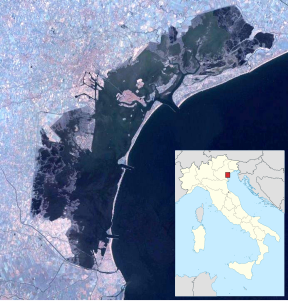Borgo San Giovanni (island)
| Borgo San Giovanni | ||
|---|---|---|
| Oblique aerial view of the Sottomarina district | ||
| Waters | Venice lagoon | |
| Geographical location | 45 ° 11 '34 " N , 12 ° 17' 35" E | |
|
|
||
| length | 5.6 km | |
| width | 3 km | |
| surface | 2.36 km² | |
| main place | Sottomarina | |
The island of Borgo San Giovanni belongs to Chioggia and closes the lagoon from Venice to the south against the Adriatic Sea. The lagoon, the open sea and the Brenta in the south form the borders of the roughly triangular, 2.36 km² island. In the northern part of Borgo San Giovanni lies the town of Sottomarina , in the west Brondolo .
history
Until the diversion of the Brenta, which originally flowed into the lagoon, the island was a peninsula. In late antiquity it was called Clodia minor , in the early Middle Ages a tribune represented Byzantine power. The Brondolo monastery was located on Clodia minor by 724 at the latest . In 856 the Doges Peter and John received King Ludwig II in this monastery. He recognized his father's contract with Venice. In a certificate from Charles III. Brondolo is expressly recognized as part of Venice in 880.
In 1229 the monastery was given to the Cistercian order , but in 1379 it was completely destroyed by the Genoese who occupied the south of the lagoon as part of the Chioggia war . After the end of the war, a fortification was built in place of the monastery and the monks had to move to the island of Santo Spirito in 1409 . The island remained uninhabited until the 17th century when it increasingly became part of the fortifications surrounding the lagoon, particularly the Murazzi built between 1744 and 1782 .
From June 2nd to 4th, 1849 there was heavy fighting over the island during the Venetian uprising against Austrian rule . The Austrian fleet had to withdraw in the face of resistance from the five fortresses in the Chioggia area. In July, the Chioggiotes were able to push the Austrians back enough that they could procure food for four days to supply the besieged city.
Today Sottomarina is known as a seaside resort.
Web links
- Website of the Cistercians with a small contribution to the monastery (Italian)
Remarks
- ↑ P. Peverelli: Storia di Venezia dal 1798 sino ai nostri tempi , Vol. 2, Turin 1852, pp. 443-445.

